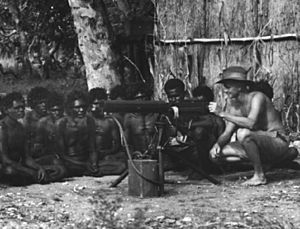Northern Territory Special Reconnaissance Unit facts for kids
Quick facts for kids Northern Territory Special Reconnaissance Unit |
|
|---|---|

Squadron Leader Donald Thomson training the NTSRU.
|
|
| Active | 1941–43 |
| Country | Australia |
| Branch | Australian Army |
| Role | Reconnaissance |
| Size | ~ 50–70 men |
| Engagements | World War II |
| Commanders | |
| Notable commanders |
Donald Thomson |
The Northern Territory Special Reconnaissance Unit (NTSRU) was a special fighting group of the Australian Army during World War II. Most of its members were Aboriginal people from the Northern Territory.
The unit was formed in 1941. Its job was to patrol the coast of Arnhem Land between 1942 and 1943. They looked for any signs of Japanese forces landing. They also trained to fight as guerrillas, using traditional weapons, if an invasion happened. In 1943, the war moved away from Australia's coast. Because of this, the NTSRU was officially ended.
Contents
History of the NTSRU
During World War II, Australia faced a big threat from Japan. This led to changes in who could join the army. Before, non-Europeans were often not allowed to join. But the war changed these rules. Special units were formed, including those with Aboriginal and Torres Strait Islander people. One example was the Torres Strait Light Infantry Battalion.
In Northern Australia, several special units were created. These units used the amazing local knowledge and bushcraft skills of Aboriginal people. They helped watch over remote parts of the coastline. The 2/1st North Australia Observer Unit in Katherine, Northern Territory was one such group.
Why Arnhem Land Was Important
East Arnhem Land was mostly empty and not well mapped before the war. But it was seen as a likely place for Japanese forces to land. This made it a very important area to watch.
Forming the Unit
The idea for the NTSRU came up in mid-1941. The unit was then formed between February and March 1942. It was led by Squadron Leader Donald Thomson. Before the war, Thomson was an anthropologist, someone who studies human societies. He had a lot of experience working with the local Yolngu people in the 1930s.
Some of the Yolngu people Thomson knew had faced legal issues in the 1930s. Thomson was temporarily moved from the Royal Australian Air Force to the Army in June 1941. His mission was to create and lead this new unit.
Who Was in the NTSRU?
The NTSRU had about 50 Aboriginal men. This included the Yolngu elder Wonggu and his sons. There were also six men from the Solomon Islands, one from the Torres Strait Islands, and several white non-commissioned officers.
The unit patrolled the coast of Arnhem Land from 1942 to 1943. They looked for any signs of Japanese landings. They also trained to fight as guerrillas using traditional weapons. Their job was to report any enemy movements towards Darwin.
Other Similar Units
At the same time, similar units were set up in other places. These included Bathurst Island, Melville Island (like the Snake Bay Patrol), the Cox Peninsula, and Groote Eylandt.
Unit Disbandment and Recognition
In 1943, the war shifted further north from the Australian coast. The NTSRU was then disbanded. Donald Thomson returned to the Air Force. He was later badly hurt in action in Dutch New Guinea. He spent the rest of the war in hospital before leaving the military due to his injuries.
The men who served in these special units were not formally enlisted or paid during the war. However, in 1992, their service was officially recognized. The Federal Government gave them pay and service medals.
See also

